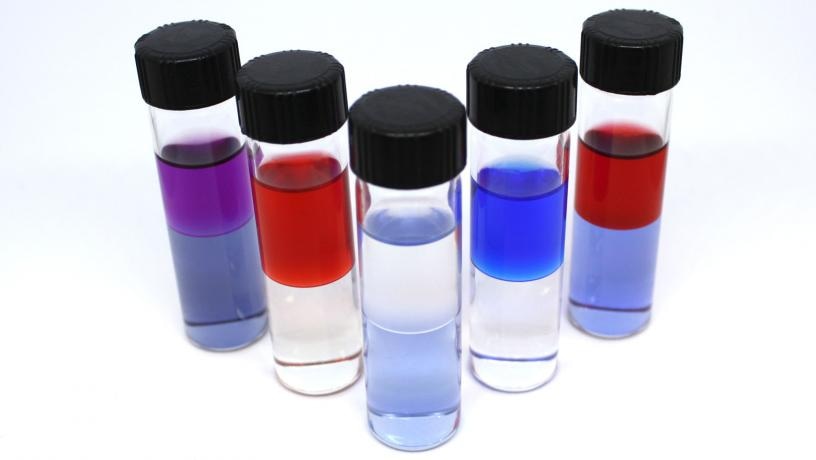May 7 2019
Hypersaline brines—water that consists of high concentrations of dissolved salts and with saline levels more than ocean water—are a rising environmental concern worldwide.
 Amine solvents (top phase) extracting water from hypersaline brines (bottom phase). (Image credit: Chanhee Boo/Columbia Engineering)
Amine solvents (top phase) extracting water from hypersaline brines (bottom phase). (Image credit: Chanhee Boo/Columbia Engineering)
These hypersaline brines are very difficult and expensive to treat and they are produced from water generated during oil and gas production, landfill leachate (a main issue for municipal solid waste landfills), inland desalination concentrate, waste matter from industrial processes, and flue gas desulfurization in fossil-fuel power plants.
If hypersaline brines are not handled properly, they can contaminate surface as well as groundwater resources. However, if there were an easy and economical method to desalinate the brines, large amounts of water would be available for all sorts of purposes, from agriculture to industrial applications, and probably even for human consumption.
A Columbia Engineering team headed by Ngai Yin Yip, assistant professor of earth and environmental engineering, announced on May 6th, 2019 that they have created a completely different desalination method—“temperature swing solvent extraction (TSSE)”—for hypersaline brines. The research, reported online in Environmental Science & Technology Letters, shows that TSSE can desalinate extremely high-salinity brines, up to seven times the concentration of seawater. This is more favorable than reverse osmosis, the optimal technique for seawater desalination, and can manage around twice the seawater salt concentrations.
Presently, hypersaline brines are desalinated either by water evaporation (distillation) or membrane (reverse osmosis). Every method has its drawbacks. Reverse osmosis techniques are inefficient for high-saline brines as the pressures applied in reverse osmosis scale with the amount of salt: hypersaline brines need exorbitantly high pressurizations. Distillation methods, which evaporate the brine, are extremely energy-intensive.
Yip has been conducting research on solvent extraction, a separation technique extensively used for chemical engineering processes. The comparatively economical, simple, and useful separation method is employed in a broad variety of industries, including the production of fine organic compounds, extraction of important metal complexes, and purification of natural products.
I thought solvent extraction could be a good alternative desalination approach that is radically different from conventional methods because it is membrane-less and not based on evaporative phase-change. Our results show that TSSE could be a disruptive technology—it’s effective, efficient, scalable, and can be sustainably powered.
Ngai Yin Yip, Assistant Professor, Earth and Environmental Engineering, Columbia Engineering
TSSE employs a low-polarity solvent with temperature-dependent water solubility for the selective extraction of water over salt from saline feeds. As it is membrane-less and not based on evaporation of water, it can avoid the technical limitations that restrict the more conventional techniques. Fundamentally, TSSE is enabled by low-grade heat (<70 ○C) that is not costly and sometimes even free of cost.
In the research, TSSE eliminated up to 98.4% of the salt, which is equivalent to reverse osmosis, the optimal method for seawater desalination. The discoveries also showed high water recovery (>50%) for the hypersaline brines, which is also equivalent to existing seawater desalination operations. However, unlike TSSE, reverse osmosis cannot handle hypersaline brines.
“We think TSSE will be transformational for the water industry. It can displace the prevailing practice of costly distillation for desalination of high-salinity brines and tackle higher salinities that RO cannot handle,” Yip continues. “This will radically improve the sustainability in the treatment of produced water, inland desalination concentrate, landfill leachate, and other hypersaline streams of emerging importance. We can eliminate the pollution problems from these brines and create cleaner, more useable water for our planet.”
The TSSE method developed by Yip has a straight shot to commercialization. The heat input can be sustainably provided by low-grade thermal sources like shallow-well geothermal, industrial waste heat, and low-concentration solar collectors. He is currently working on further refining how TSSE works as a desalination technique so that he can engineer further enhancements in performance and test it with real-world samples in the field.
A New Paradigm for Desalination
A new paradigm for desalination. (Video credit: Jane Nisselson)